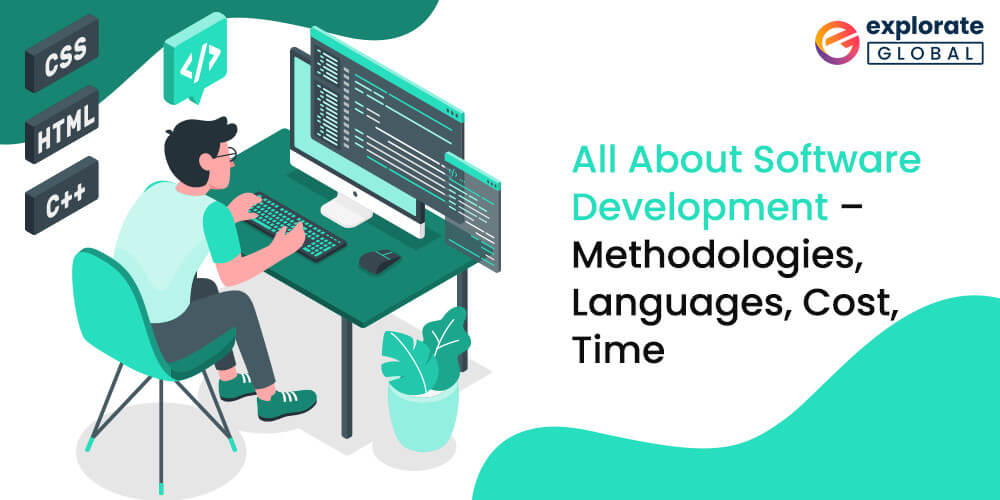
What is a software development firm?
A software development company is a company whose primary job is to produce various forms of software, software technologies, distribution and software product development. Software Development companies can also be tasked to design and develop websites, design and develop applications for different types of operating systems. While some software companies are involved in the core job of software production from front end or back end design, other software development companies might be involved in execution of general software projects.
Software development companies in a nut shell is a term coined for companies that produce useful programs, create digital solutions for problems, build corporate systems and design websites, provide technical insights and supply business intelligence in order to enhance productivity, increase profit margins, decrease processing time, induce process automation, facilitate work-flow management, elevate businesses by optimizing B2B and end user analysis and much more.
What Are the Different Types of Software Development Methodologies?
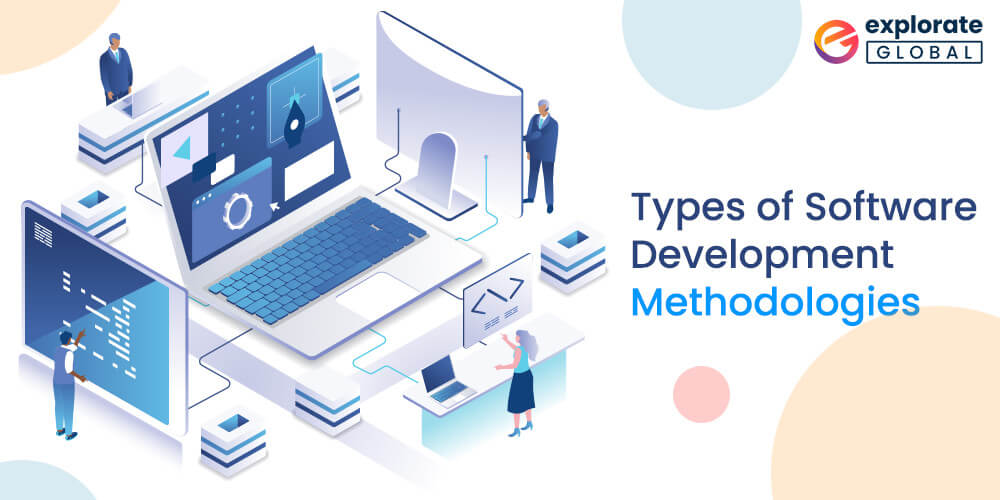
The world of software development is endless and so are the methodologies used for software development. These software development methodologies are basically the process involved in software development. The software development methodology is the structure used for planning and controlling of the process and procedure involved in the development, design, and creation of a software. The various software development methodologies are:
1. Waterfall Model
Waterfall Model is considered as the most traditional way of developing a software wherein the process of software development is broken into a sequence of pre- defined steps in a linear and progressive fashion, without breaking or changing the sequence.
Steps of Waterfall Model:
-
- Requirement gathering and analysis
- System design
- Implementation
- Testing
- Deployment of system
- Maintenance
Pros of Waterfall Model:
-
- Easy to understand
- Easy functionality
- Simplified process for rigid problems
- Time saving technique
- Easy testing and analysis process
Cons of Waterfall Model:
-
- Only precise needs can be matched
- Can’t be used for maintenance projects
- Possible outcome can’t be predicted in advance
- Can’t be used for projects with long term life
2. Prototype Methodology
Prototype Methodology is a specialized form of software development wherein a Prototype i.e. sample of the software, is created and only after validation of the functionality of the prototype and implementation of changes and modifications and relevant updations, an authentic and finalized solution is presented.
Steps of Prototype Methodology:
-
- Initial requirement gathering
- Design = prototyping = customer evaluation = review and updation
- Development
- Testing
- Maintenance
Pros of Prototype Methodology:
-
- Gives clarity of functional process of the software in advance
- Reduced risks of failure during live functionality of software
- Perfunctory in requirement gathering
- Well- equipped overall analysis process
Cons of Prototype Methodology:
-
- Management cost might suffer a upsurge
- Excessive involvement and critiquing from customer is involved thus altering processing negatively
- Too many changes lead to adverse effect in the workflow of software
3. Agile software development methodology
Agile software development methodology is an innovative approach towards software development used for well-organized project management procedure that allows for recurring alterations, updations, modifications and changes.
Steps of agile software development methodology:
-
- Discussion
- Analysis
- Strategy/ Plan
- Design
- Execution
- Qualitative analysis
- Release
- Testing
- Feedback
Pros of agile software development methodology:
-
- Adapts to changes and updations efficiently
- Transparency
- Direct communication
- Improved quality
- Finds and fixes bugs quickly
Cons of agile software development methodology:
-
- Lacks documentation efficiency
- Since outcomes are not clear, chances of getting off track are pretty high
4. Rapid Application Development
Rapid application development as the names suggest is used for developing such a software that requires rapid solution by using prototypes for functionality testing without effecting the end product.
Steps of rapid application development:
-
- Requirement planning
- User design = prototyping = construction
- Testing
- Cutover
Pros of rapid application development:
-
- Process of software development becomes effortless for developers
- Clients are assisted for generating quick reviews
- Customer feedback is encouraged for further improvement
Cons of rapid application development:
-
- Modularized systems are used
- Level of skills of Developers required is extremely high
- Can be used for projects with high budgets
- Performance is team dependent
5. Dynamic System Development
Dynamic system development is derived from rapid application development methodology wherein an iterative and incremental approach is used focusing on the user involvement.
Steps of dynamic system development:
Feasibility study and business study
/ \
Functional model + Implementation
\ /
Design and build
Pros of dynamic system development:
-
- Users also understand the software development process
- Quick and speedy functionality deliverables
- Easily accessible to end users via developers
Cons of dynamic system development:
-
- Expensive implementation
- Unsuitable for small sized enterprises.
6. Spiral Model
Spiral model is a highly sophisticated software development procedure with risk reduction feature that implements itself in the early stages of the project. It’s similar to incremental model with added emphasis on risk analysis and reduction.
Steps of spiral model:
-
- Objective identification and determining the alternative solutions
- Risk identification and risk mitigation
- Development of next version of the product
- Reviewing and planning of the next phase of the project
Pros of spiral model:
-
- Reduced risk factors
- Most suitable for large and complex projects
- Additional functionalities are allowed later on
- Highly suggested for projects with high risks and varied business needs
Cons of spiral model:
-
- Expensive software development procedure
- Though chances of failure of risk analysis are very low, but if the same happens then the entire project will be damaged
- Ill- advised for projects with low risks
10 Most Popular Software Development Languages
A programming language is a set of commands, instructions and other syntax used to create a software program. It can also be defined as a formal language that consists of a set of instructions that produce various kinds of outputs. Programming languages mostly include instruction for computers.
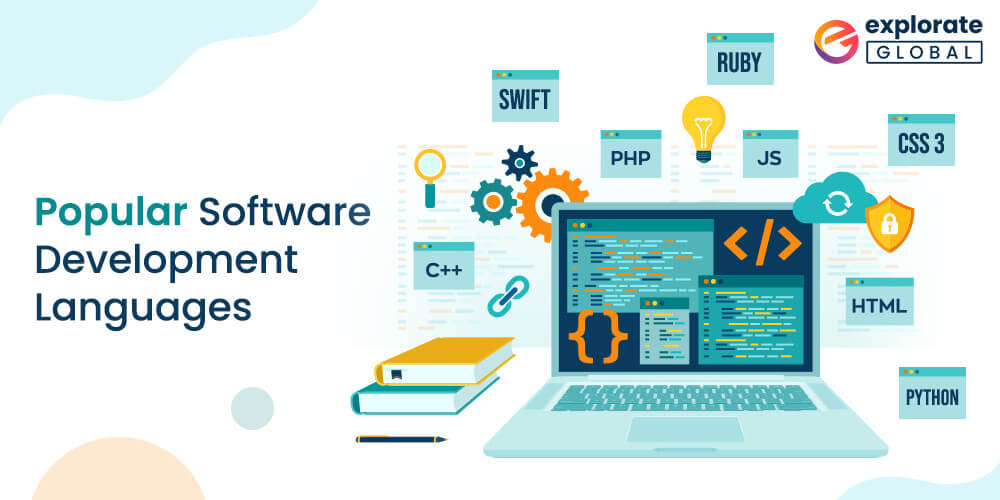
The programming language used by software developers for developing a software are called as software development languages. Some of the popular software development languages are:
1. Python Development
Python is a high level, interpreted and general purpose programing language with enhanced code readability and usage of significant whitespace. Python development uses language constructs and object oriented approach to write programming codes that are clear and logical irrespective of the project size.
Python was designed by Guido Van Rossum in 1991 and can be used on various Operating Systems such as Linus, MacOS, Windows 8 and more.
Pros of Python development:
-
- Easy to read, learn and write
- Improved productivity
- Python is an Interpreted language, thus code can be executed directly line by line
- Dynamic in nature
- Free and open sourced
- Has support of vast libraries
- Portability
Cons of Python development:
-
- Slow speed
- Memory efficiency is low
- Mobile computing is on the weaker side
- Pythons’ database access layer is primitive and under- developed
- Due to its dynamic nature, runtime errors occur.
- Thorough testing is required
2. JavaScript Development
JavaScript or JS is a high level, just in time compiled and multi-paradigm programming language that conforms to ECMA Script specifications. JavaScript development has dynamic typing, first class functions, prototype based object orientation and curly bracket syntax.
JavaScript was designed by Brendan Eich in 1995. JavaScript is an event driven, functional and imperative paradigm based programming language.
Pros of JavaScript development:
-
- Speed of execution is high
- Easy to learn and understand
- JavaScript is the most popular language at the moment since all famous companies such as Google, Amazon, PayPal etc., are using it.
- High Interoperability i.e. ability to work with other languages is very high
- Minimized server load
- Rich pre designed interfaces
- Extended functionalities such as third party add-ons like GreaseMonkey allow the developers to add snippets of pre-defined code in their codes which in turn saves time and costing.
- Versatile in nature due to its capability in both front- end and back- end development
- Codes contain less overheads
Cons of JavaScript development:
-
- Missing client side security
- All browsers might not support it
- Lack of debugging facility
- Supports only single inheritance
- Sluggish bitwise function
- Single code error can stop the rendering of entire JS code on the website
3. Ruby Development
Ruby is high level, general purpose, interpreted programming language with multi paradigm which is functional, imperative, reflective and object oriented.
Ruby on rails development was introduced by Yukihiro Matsumoto in 1995. Its language of implementation is C with cross platform Operating System.
Pros of Ruby development:
-
- Dynamic in nature
- Simplified and faster creation of web apps
- Small, elegant and powerful code
- Since ruby is an open source language, its free to copy, use, modify and distribute
- Dynamic loading of extension libraries
Cons of Ruby development:
-
- Low runtime speed
- Limited documentation
- Limited community and support for ruby
- Processing time is high or processing speed is low
4. C# Development
C Sharp or C# is a general purpose, multi paradigm programming language designed and developed by Microsoft in 2000.
Features of C# development:
-
- Static typing
- Strong typing
- Lexically scoped
- Imperative
- Declarative
- Functional
- Generic
- Object oriented (class-based)
- Component oriented
Pros of C# development:
-
- Cool syntax
- Great generics report
- Extension methods are available
- Automatic garbage collection
- Automatic memory management
- High performance
- Amazing cross platform support
- Great lambda support
- Productive
- Great readability
Cons of C# development:
-
- Poor x-platform GUI
- Low flexibility
- Since C# is a part of .NET framework, the server running the application must be windows.
5. LISP
LISP is a family of high level programming languages that are second oldest in order, developed in 1958, as a practical mathematical notation for computer programs. LISP has changed over the year and currently available dialects are Racket, Common Lisp, Scheme and Clojure.
LISP is an acronym for List Processor, with a distinctive full parenthesized prefix notation which was used as a favored programming language for Artificial Intelligence.
Pros Of LISP:
-
- Flexibility
- Stability
- High performing language
- Can be integrated with C
- Multi paradigm
- Open source language
- Purely functional in nature
Cons of LISP:
-
- Poor readability
- Unintuitive syntax
- Poor learnability
- It’s not easy to understand
6. Perl Development
Perl is a family of two high level, interpreted, general purpose and dynamic programming language which is imperative and object oriented in nature.
Perl was designed and developed by Larry Wall in 1987. The Perl language has 2 versions Perl 5 and Perl 6 or Raku.
Pros of Perl Development:
-
- Follows traditional approach by using braces for functions and loops
- Extremely powerful programming language
- Versatile in nature
- Multi-purpose language
- Cross platform operating systems
- Very mature and sophisticated
- Can be imperative or object oriented or procedural, depending upon the need of the programmer or task.
Cons of Perl Development:
-
- Sometimes code can be untidy
- Slower scripting
- Poor implementation of Object oriented function
- No portability
- Poor in argument handling
7. MATLAB
MATLAB is a proprietary multi paradigm programing language and numerical computing environment developed by MathWorks in 1986, which allows for matrix manipulations, function plotting, data plotting, algorithm implementation, user- interface creation and interfacing with programs written in other languages.
MATLAB is multi paradigm in nature with features such as functional, imperative, object oriented, procedural and array.
Pros of MATLAB:
-
- Different library support
- Ease of use
- Platform independence
- Device independent plotting
- GUI and Compiler
Cons of MATLAB:
-
- Highly expensive
- Slow execution speed
8. Structured Query Language or SQL
Structured Query Language or SQL is a domain specific programming language used for managing data held in relational database management system (RDBMS) or for steam processing in RDBMS. SQL is primarily used for handling of structured data.
SQL is a declarative paradigm based programming language designed by Donal D. Chamberlin and Raymond F. Boyce in 1974.
Pros of SQL:
-
- High speed of query processing
- No coding skills re required hence making it extremely easy to read, write and learn.
- Standardized language
- High portability
- Interactive language
Cons of SQL:
-
- Interface is very complex
- Costly
- Only partial control is awarded to the database
9. PHP Development
PHP is a general purpose scripting language designed by Rasmus Lerdof in 1995. PHP development is well suited for building web applications. Its paradigm is imperative, functional, object oriented, procedural and reflective in nature.
Pros of PHP Development:
-
- High speed of custom web application development
- Simplified maintenance of web applications
- No need to write redundant or additional codes
- PHP works more efficiently with databases
- Automation of common web application tasks
- High security and protection of websites against targeted security attacks
- Not very costly
Cons of PHP Development:
-
- Lacks the option of modifying core behavior
- Quality of PHP frameworks differ
- Programmers need to learn PHP frameworks instead of PHP
10. Dot NET Development
Dot NET or .NET is a software framework developed by Microsoft to run on Microsoft Windows in 2002. .NET contains a large class library called as Framework Class Library, which renders language inter- operability across several programming languages.
Pros of Dot Net Development:
-
- Due to object oriented software development model, the code becomes easier to manage and combine
- Reliable
- Simplified caching system
- Cross platform design
- Flexible deployment
- Easy maintenance
- Large community and support
Cons of .NET Development:
-
- Limited object- relational support
- Licensing cost is high
- Large gap between release and stability
- Memory leaks
5 Factors Affecting Software Development Cost
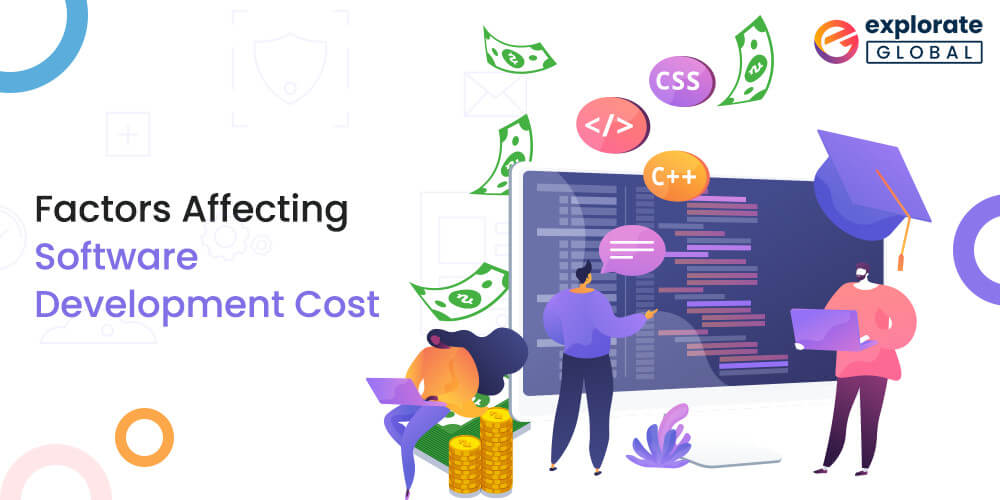
The final cost of any software development project can’t be calculated with exact precision at the very beginning of the project since any software under development process is subjected to various external factors that impact the running cost of the project, thus affecting the final costing of the software. There are various factors affecting the software development cost, namely:
1. Time affects software development cost
Software development can take from a few hours to many months depending upon the complexity of the program. Software with low level of complexity takes few hours while software with high level of complexity might take many months to develop. The longer the time taken for project development, higher will be the cost of the software development.
2. Software development cost depends on project scope
As discussed above, more complex the project scope, higher will be the time taken and more will be the cost involved in software development. Similarly, lower the complexity of the/scope of the project, lower will be the time required to develop the software and lower will be the cost of software development involved.
3. Software development cost depends on the number of developers
The cost of software development is also effected by the number of people involved or the manpower involved in software development process. More the team size more will be the cost.
Also, if a project is of very high complexity, thus requiring more number of developers, then cost of the project will increase further since highly skilled developers cost significantly higher than other team members involved.
4. Software development cost depends on outsourced company location
Company location is another factor that can add or subtract from the software development costs substantially. Depending upon the location of the company and the country orientation of the company, the pay of the staff is decided. For example, if the project is outsourced to India then the cost of manpower will be certainly low. We could also say that the cost of paying one developer in USA is somewhat more than the cost of paying a small team of software developers in India.
Similarly, if the company belongs to USA then the cost of manpower and highly skilled developer will only add exponentially to the cost of software development project. Even with USA, the cost of hiring a developer from New York is far more than the cost of hiring a developer from Virginia.
5. Additional/Extra Software development cost
More than often there are some additional and unexpected costs that impact the final costing of the entire software development project such as subscription costs or cost of buying a licensed software that might aid in software development. The additional cost could be of buying a server or renting a hardware like servers or some infrastructure related costs. Sometimes a system or software might need upgrading or some other maintenance fees might be incurred over time ranging from security upgrades or repairing cost of a feature that has stopped working. Such additional costs sometimes may even generate from the need of updation and maintenance of a code or syntax over time.
Also you shouldn’t forget to add in the additional cost involved in training the new staff in using the new software and also the costs involved in data migration from old software to new software.
Such additional costs should be anticipated. If they can’t be anticipated or estimated in advance, an additional sum of money should be reserved in advance and kept aside for such additional and unexpected expenses.
How Much Time Does It Take to Build a Software?
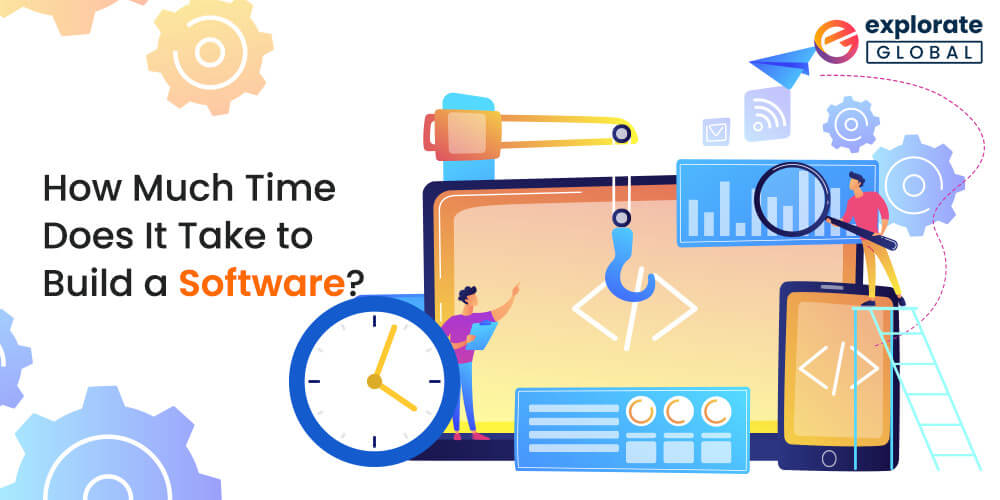
The time taken for Developing a software varies from software to software. Some software is so easy that it might take a developer a few hours to build it, while some software is so tricky and multifaceted that they it might take several months for the software developer or developer team to finish it off. The time involved in software development is dependent upon a few basic factors such as complexity of the software, size of the software, level of complexity involved in data collection and integration, inward delays and outward delays.
If the Complexity of the software is low, then time taken to build the software will be less in comparison to the software with high level complexities.
Software with good size take more time to build then small sized software.
If the level of complexity involved in data collection and data integration is high or if the process of data collection and integration is time consuming, then it automatically adds up to the total time required for software development.
Then there are issues with inward and outward delays. Inward delays are when the delaying factors are attributed by the development team or development company, such as unskilled developers or hiring and firing of members from the development team of an ongoing software development project or any other factors that might contribute to delay from the software development team side. While, outward delays are the reasons of project delay caused by the client such as delay in providing any approval regarding any updation or change or modification or with regards to an additional cost countered while working on a project; delay in providing any sort of client side data etc.
To sum it up, a customized software with high level complexity and of sizeable nature might take four to nine months on an average, to complete, in the most extreme case scenario.
How to Hire the Right Software Developers?

Every fourth person you meet today is some sort of software engineer or software developer or coder or tester or somehow involved in software building business. The number of people working in and working for software development business is increasing exponentially, but despite of so many software developers and software development companies, there is still a dearth, dearth of exceptional and skilled developers who know what they are doing and understand the demands and requirements of their clients. In this sea of developers, coders, testers, engineers etc., it is indeed a very difficult but yet the most important task to find the perfect match of development company or development team or developer for your software development project.
Hence there are certain factors that you need to keep in mind and certain instructions you need to follow and some cautions you need to adhere to in order to find your perfect match of software developer for your software.
1. Take your time
One of the most common mistakes founders make while hiring software developers is rushing the process of selection and settling for unskilled developers or misfit candidates or worse. Mediocre or bad developers only slow down your software development process and add to your costs apart from generating unsatisfactory or abysmal results. Hence, take your time, interview your candidates thoroughly, define your exact expectations in software and developer. Only when you find a software developer or software development agency who understands your vision and is compliance to what you want and agrees to your terms and conditions, you should give the go ahead. Don’t settle, be precise and search for the ideal candidate because finding not only someone skilled is important but also someone you can work with.
2. Avoid the one-man show
Invest in a balanced all around software development team with several great team players rather than a one-man army. Even if the team members have only average skills, but sometimes putting together average people in a team is what shows their real value and makes their strengths come to play. Your chances of a big win are solidified when you put together a team of skilled professionals who can work together. If you go for a one-man army or a single star player who is master of all trades, you have a fair chance of getting someone who wants to run the show by himself and might over run your ideas and expectations. Hence, invest in a team of hungry and ambitious players whose skills complement each other and incite each other’s creativity and innovation approach.
3. Choose the young and hungry
Seasoned players might know their craft and have a buck load of experience to add to their credentials but over time the big and old names sometimes become stagnant and conceited since they are so set in their ways that they don’t want to do something different. Their productivity and knowledge and skills might be unmatchable and unbeatable but then the seasoned and experienced software developers are also someone who don’t like to get out of their comfort zones and do something new and risqué. They have their tool belts, approach, software patterns and language preferences already planned in their head. If your requirements are in line with their thinking, you are lucky else you will be roughshod until you are ultimately convinced that your way and vision is wrong and final product is going to be something unrecognizable to you.
To avoid such circumstances, go for the young and hungry who are dying to prove themselves, who will try to give you the software of your dream not because they are getting paid but because it’s a matter of pride and joy for them, a matter of proving their worth and merit to not only the world but themselves as well. Their hunger for success, youth, inexperience, ambition, passion and enthusiasm will only make them innovative, hard- working, adjustable, adaptable, creative and more willing to accommodate your vision.
4. Cultural fit
Importance of technical and technological skills of a hired software developer are very important for the success of the project but also some percentage of concern should be dedicated to finding the developers who do well in fitting in culturally. Employees don’t quit their jobs but rather their work place, is a very true saying. Hence we should aim at making the workplace ambiance and culture so lively and relative that every high should be celebrated together and every low should bring the team closer and form a tight knit unit.
The candidate should be able to form a bond with the organization and identify himself or herself with pride with his or her organization. Let them talk to other team members and find out for themselves if the company is going to be a good cultural fit for them, during employee initialization process. This will also help the new member to forge bonds with other team members whilst showing the true image of the company.
5. Let them play
Most software developers are creative people who don’t need an office atmosphere stifling them but rather a work place which gives them the power to be innovative and creative in order to bring about effective and efficient results. In order for the developers to realize your ideas, they need to come up with innovative solutions and that can only happen if you let them do their job without breathing down their necks. Set their boundaries by giving them deadlines but don’t suffocate them so much that they reach dead ends rather than deadlines.
This will only result in higher motivation, gratitude and productivity.
What are innovative developments?
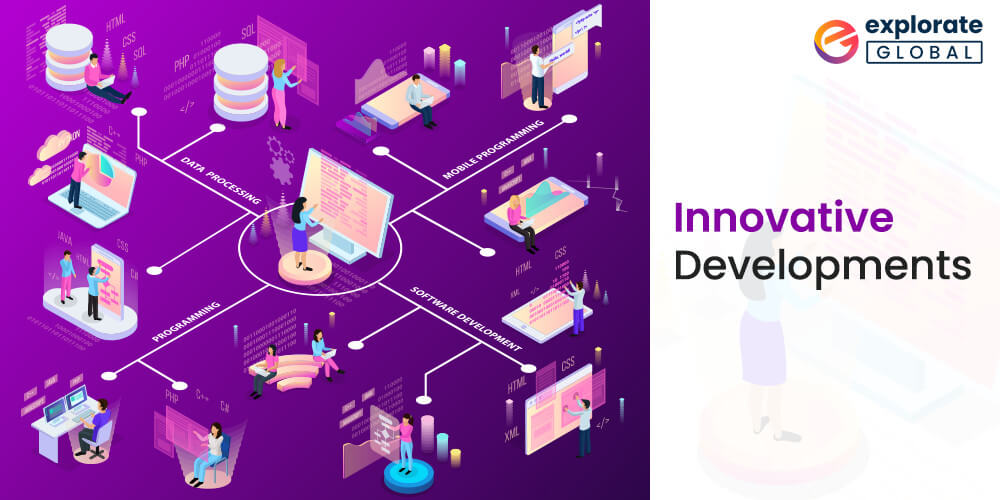
Innovative development could possibly be defined as a development that takes places when all decisions, activities and their impacts and results that occur from the core of problem recognition or need recognition are done via the process of innovation through diffusion and ultimately, the adoption of innovation by users.
There are four major types of innovative developments such as:
1. Architectural Innovation Development
Architectural Innovation wherein an existing technology is introduced in a new market. The skills, lessons and overall technology of one market scenario are taken and applied in a different market scenario. The risk is low due to usage of already tried and tested technology and most of the times the results are amazing in getting the customer reception and attention. For Example, Winchester disk drives, desktop photocopiers, multi core processor etc.
2. Radical Innovation Development
Radical innovation wherein a new technology is introduced in a new market. Radical innovation development in simplest terms can be defined as the technological breakthrough that leads to transformation of industries and often creates new market in its technological revolution. For example, Netflix, Amazon, PayPal, Apple etc.
3. Incremental Innovation Development
Incremental innovation wherein an existing technology is re-introduced in an existing market. The existing technology is utilized in such a way that its value increases to the already existing market of customers either by revamping or up-gradation or simplification or reducing the size of the pre-existing technology. To simply, incremental innovation development is a gradual and continuous development process of improvement of an existing technology, products and services. For example, process automation, waste minimization, internal process and tool improvement, product and service improvements etc.
4. Disruptive Innovation Development
Disruptive innovation wherein a new technology is introduced in an existing market. As it is stealthy in nature it’s also called as stealth innovation. The newer technology might be expensive and difficult to use but after a few iterations, it might become the technology to beat all its predecessors and revolutionize the company’s existing market. Disruptive innovation disrupts the existing market via the introduction of new business or product or technology. For example, RadiOS, Video Streaming, Smartphones, Personal Computers, Desktops, Mini Mills, Retail medical clinics etc.
What Questions to Ask the Software Development Company Before Signing the Contract?
- What is your technical and technological expertise?
- What is area of specialization?
- Why is your company right for my project?
- Who all will be working on my project?
- How will I monitor and check the project process?
- Do you allow for NDA (Non Disclosure Agreement)?
- What does your typical process and timeline look like?
- What is your project management process?
- Could you provide us with the testimonials and contact details of your previous customers?
- Could we see some of your previous work done?
- Have you done any work that is similar to my project?
- What are your quality policies and guidelines to ensure that you understand my project’s requirements?
- How and when will you communicate with me?
- What will be my involvement during the entirety of the project?
- What will you do reduce risk and increase the chances of success
- Who will own the code after the project completion?
- Will you or who will be looking after the maintenance once the project is done?
- What is post project completion policy or guideline?



5 thoughts on “Software Development Methodologies, Languages, Cost and Time of Development”